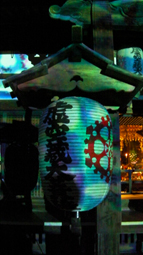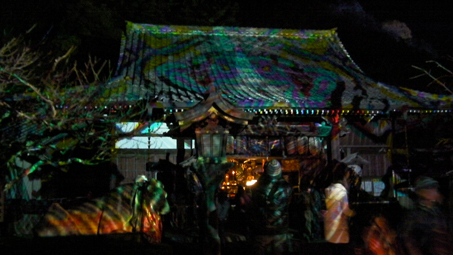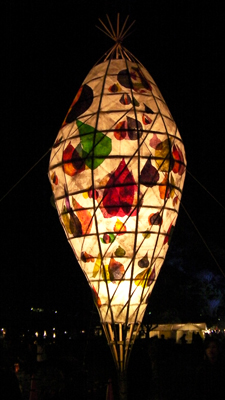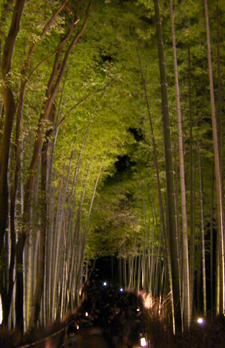
mostly psychedelic.

The light show at Horinji Temple swirls between hypnotic, kaleidoscopic and …
Japan has a long history of celebrations that have light as a key element, ranging from serene moon viewing parties to full-on fire festivals. This may explain the popularity of the many night-time illumination events, both large and small. Kyoto also has a number of impressive displays, including the Arashiyama hanatoro, literally “path of flowers and light,” which takes advantage of the area’s traditional architecture and landscape to spectacular effect.
The Arashiyama hanatoro is a major production incorporating thousands of lanterns and other lights spread along a five kilometer route (links below), in addition to the illumination, displays and performances staged by local temples and other spots. The “flowers” part refers to the many large ikebana and other floral decorations dotted along the path.

Some “lanterns” are several meters tall.
Despite the grand scale though, the lighting mostly accentuates the contrast with the night-time shadows and creates a warm ambiance (which somehow doesn’t offset the late Autumn cold – dress warmly). Given the size, it makes more sense just to enjoy wandering the main route, visiting the places with free admission and adding a couple of the paid spots. Factor in at least one stop for some warm amazake and snacks.
The course loops around so you can start anywhere but here is my path this year as a rough guide.
Horinji Temple (法輪寺)
From Keifuku Randen Arashiyama Station, I crossed Togetsukyo Bridge and headed for Horinji Temple. The bridge itself looks spectacular, bathed in a wash of golden light… but I’m less sure about the purply blue of the mountain backdrop. Keep your eyes open for the entrance to Horinji. The gate is easy to miss but once inside a flight of stairs leads you up to surprisingly large grounds with a panoramic view of Arashiyama.
The main attraction here is a light show that covers the central building and surroundings in a continually changing, and very hypnotic, kaleidoscope of colors. Make sure you head over to the lookout though to soak up the lantern display and night view. The last time I was here, a female artist also performed several very beautiful and haunting songs later in the evening. The performance schedule for all spots is posted on the hanatoro Web site but unfortunately it’s in Japanese only.
Bamboo forest walkways (竹林の小径)
After Horinji, I looped back toward the bridge, stopping off along the river to see the lantern display. I call them lanterns because they are crafted from hand-painted washi paper stretched over bamboo frames but many actually stand up to two, three or more meters tall. Definitely worth a look.

The bamboo walkway glows golden.
This year, I decided to skip Hogonin (宝厳院) and later Jojakkoji (常寂光寺) Temples. Both places are highly recommended but I had visited a couple of weeks earlier to see the Autumn leaves. Instead I headed for the bamboo forest. This walkway is one of the symbols of Arashiyama but I have to say the photos are misleading: only a small area is usually worth seeing. That all changes dramatically during the hanatoro though, when virtually the whole length is flooded with light.
Before you enter the (one-way) walkway, take a moment to visit Nonomiya Shrine (野宮神社), which is just off to the right before the bamboo. It’s a small place but has definite rustic charm as well as a lush moss garden. I was also lucky enough to catch a performance of gagaku imperial court music by the shrine priests. It’s a unique sound and probably an acquired taste but it was perfect for this particular evening.
Okochi Sanso Villa (大河内山荘庭園)
After the bamboo, my plan was to head for the Rakushisha Hermitage (落柿舎) and Nisonin Temple (二尊院) but I got waylaid at Okochi Sanso Villa. I had passed the villa many times without going in, assuming it would be pretty dry stuff. But not so: the property is actually spread over some 20,000 square meters and includes several beautifully manicured gardens. The path connecting them gradually winds its way up the hillside to a lookout with a view that stretches back to Kyoto City.
Okochi Sanso was definitely the highlight of the evening and by the time I left the illumination was about to end. A quick word of warning: the area is magical while it is lit up but suddenly becomes wrapped in darkness when the lights go off. Almost all of the Japanese tourists also seem to mysteriously vanish at the same moment. On the way back, I was even surprised to spot what had to be a wild boar as it chugged off into the bamboo. An eerie end to a pleasant evening.
Resources and other details
Official info: Japanese top page and English top page for the Arashiyama section of the hanatoro Web site. The site also has English information on the Higashiyama hanatoro.
Illumination period: The illumination runs from 5:00 to 8:30 pm (sharp) each day during a period from early to mid-December. Last admission to most places is 8:00 pm.
Entry fees: During the illumination, entry to Horinji and Nonomiya is free, Rakushisha is 200 yen and Hogonin, Jojakkoji, Nisonin and Okochi Sanso are all from 400 to 600 yen.
Local access: From Kyoto, Arashiyama is easiest reached via the Keifuku Randen Arashiyama Line. You can either change to the Randen at Uzumasa Tenjingawa Station, the final stop on the subway’s Tozai Line, or Shijo Omiya on the Hankyu Line. From Osaka, take the Hankyu main line to Katsura and change to its Arashiyama Line. It is also possible to take the JR Sagano Line from Kyoto Station to Saga Arashiyama Station.
